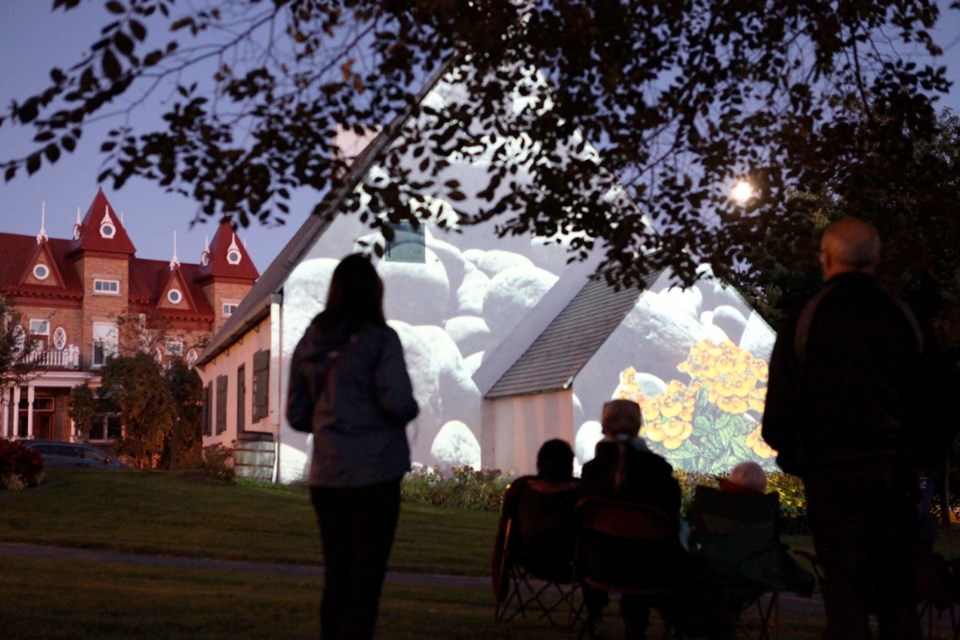What: Invocations: Video Projections About Place and Time
Where: Various locations, including Emily Carr House, the Chinese Cemetery and FLUX Gallery (821 Fort St.)
When: Sept. 13 through Sept. 2
Admission: Free
Urban art excels when creators focus on overlooked areas — a nondescript park used as a shortcut to the grocery store, or a commercial building left untenanted for years — and cast them in a new light.
Organizers of a new visual-art showcase, Invocations: Video Projections About Place and Time, are taking that approach to heart. Six artists will project videos of their making on buildings and backdrops in a variety of locations. Victoria artists Marianne Nicolson and France Trepanier join Cooper (Ottawa), Allison Moore (Montreal), and Paul Wong and Jeffery Chong (Vancouver) at the event, which runs through Sept. 22 at various venues, including Emily Carr House and the Open Space Arts Centre.
“It’s great to have artists of this calibre show their work, but there’s also the component of community,” said program director Catlin Lewis of the Flux Media Art Gallery, which is part of the non-profit organization MediaNet.
“We are bringing people together to look at these places that they might walk by every day, and to have them start thinking more about Victoria — the cultures that are here and the histories that are here.”
Lewis said the gallery toyed with a similar idea in 2010 with another exhibition that was more individual by nature. The themes being explored during Invocations tackle Greater Victoria as a whole, albeit with each artist’s personal perspective.
Lewis said she left the decision-making up to each artist, but asked them to focus on the history of their location. “Through their work, you can invoke the spirit of a place or some of the stories about that place and have them come to light, figuratively and literally.”
Installations will be located both indoors and outdoors. MediaNet recently moved its gallery to 821 Fort St., a location with a wide-open street view. Nicolson will use the windows of the gallery as a backdrop for her looping imagery about the 1914 McKenna-McBride Land Commission and Indigenous rights. It will play overnight in the gallery beginning Tuesday until Sept. 22, Lewis said. “When people walk by at night, they will see her images.”
Moore, who was raised in Victoria but now lives in Montreal, will explore the history of Fort Commons, the courtyard area behind Starbucks at the junction of Fort and Blanshard streets, and the surrounding area on Friday. Her show at Fort Commons, which will also include elements of Victoria’s haunted past, will be followed by an 8 p.m. reception at the nearby Flux Media Gallery.
Ottawa-based experimental filmmaker Cooper, who only goes by one name, asked for permission to use Emily Carr House on Government Street, and will screen his project, The Essence, at the National Historic Site at 8 p.m. on Saturday.
Trepanier focused on water and its role in the cycle of life for her entry, which will be presented in Open Space Arts Centre through Sept. 22, with a reception on Saturday at 8 p.m.
Cooper, Wong and Chong are the only participants not from Victoria, so Lewis served as a location scout for Cooper. Wong and Chong did some reconnaissance of their own and came up with The Chinese Bone Collector at the Chinese Cemetery, for which they received permission from the Consolidated Chinese Benevolent Association.
The pair of Vancouver artists opened the festival Wednesday with a ceremony where early photographs of the Chinese community in Victoria and archival footage of Chinatown were screened on surfaces in the cemetery.
Chong’s great-grandfather is buried in the cemetery, a nice bit of serendipity. “It tied in the greater concept — what life was like for the early Chinese community — and personalized it, by bringing their own meaning to it,” Lewis said.
